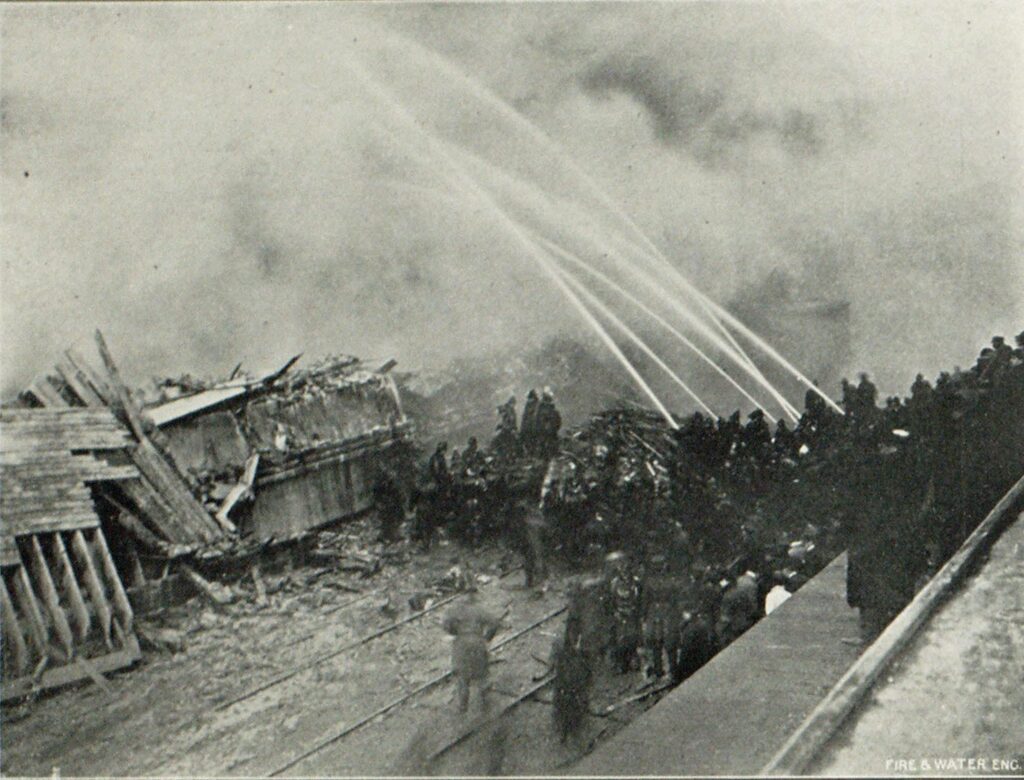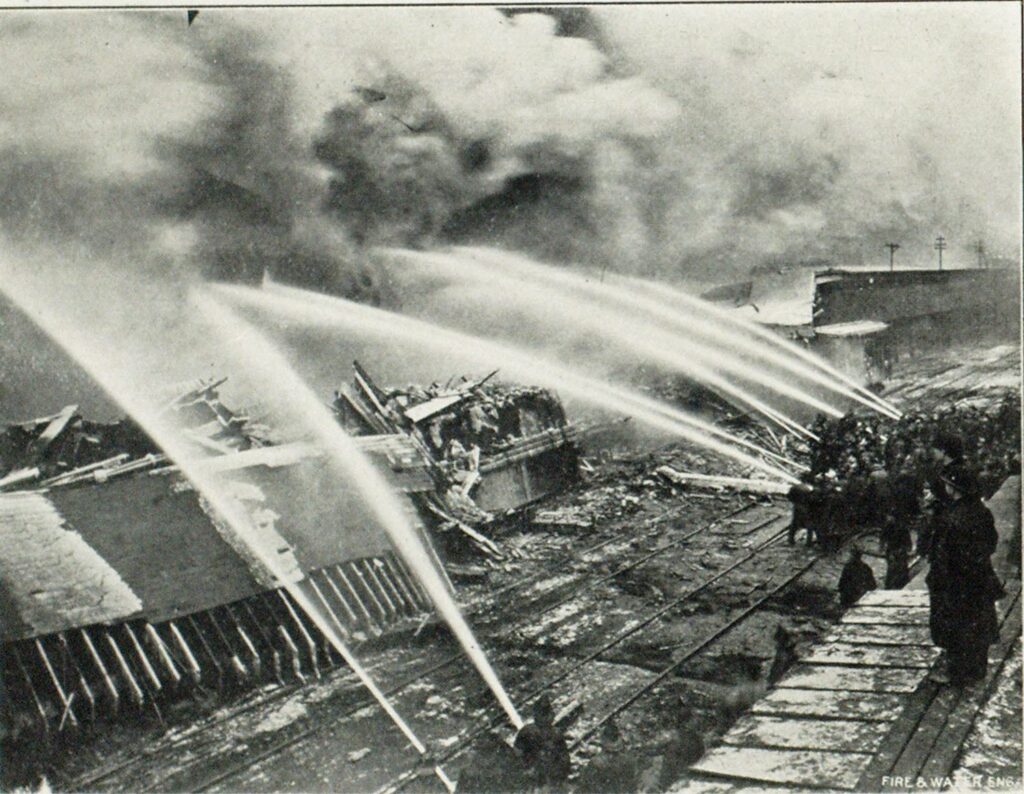From the Archives: Chicago Stockyards Fire LODDS

VIEW OF CHICAGO STOCK YARD FIRE UNDER CONTROL
The funeral of Fire Marshal James Horan, who met his death in the stockyards fire, with 22 other members of the Chicago department, took place December 26. Mayor Busse rode in the procession in the mourners’ section, and Chief of Police Steward and Assistant Chief Schuettler led several platoons of police on foot. Acting Fire Marshal Seyferlich marched at the head of a section of firemen. The coffin, borne on a hose cart, wa attended by a guard of honor consisting of fire department division heads, and was followed by a line of equipages extending back for a mile and a half. Immediately following the purple-draped hose wagon which bore the marshal’s body was driven his automobile, the one in which he made a record breaking dash to the fire and to his death. The rear seat was occupied only by a fire marshal’s helmet.
Marshal Horan’s friends were legion. They were found in every walk of life and in every class. He joined the department in 1881 as water boy at the old No 1 station, and was soon promoted to the position of pipeman and five years later became a lieutenant. He became a captain soon after and on July 1, 1883, he reached the position that ultimately brought him to the head of the department. On this date he was appointed to the position of third assistant fire marshal. In October, 1904, he became second assistant. Following this he capped the climax of his career by becoming chief of the department in July, 1906.~ Probably no man that has ever been connected with the Chicago fire department has had as many adventures and made as many thrilling rescues as the chief who lost his life in such a sad manner. His friends said of him that he was absolutely lacking in all sense of fear and was always in the thickest of the battle. He never sent his men any place that he would not go himself. For this reason no man was more idolized by his comrades than Chief Horan. One of his most amusing peculiarities was his exceeding modesty and no one could be made more uncomfortable and embarrassed than he by making any reference to his personal prowess. Tt was said of him that it was the hardest thing in the world to make him talk about himself. “I’m not a hero,” he used to say when questioned, “I’m iust a fireman. It is all in a day’s work.” “Water boy,” pipeman, lieutenant, captain, battalion marshal, third assistant marshal, second assistant chief, first assistant chief, chief of the departmen…this is the record of the man. He was 51 years old.
Volumes might be written about the winning characteristics of the dead chief, but one of the most pathetic instances in connection with his tragic death was the finding in one of his pockets of several letters from children, telling Santa Claus of their Christmas desires. These were to have been attended to by the marshal a day or two later.
The “Fire Fans,” a little band of about seventy-five of the tried and true friends who formed his personal staff and faced all sorts of exposure and danger to be at his side, where the flames were the hottest, joined in paying to James Horan the tribute few men may take in passing the great divide. These men, representing heads of great business enterprises, professional men and men about town, gathered in little groups and shed genuine tears as they spoke a tender word for the deceased. The chief married the second time six years ago, after he had been a widower for several years. His second wife and four children survive him. James, 22 years old, and Margaret, 18, are the children by his first marriage, and William, aged three, and Ella, two years old, are by his second marriage.

FIGHTING THE STOCK YARD FIRE IN ITS WORST STAGE IN EXCESSIVE HEAT.
Perhaps the most noteworthy case in the experience of Chief Horan was in the fire which destroyed the building at 98 Washington street in 1900. There had been an explosion of celluloid and flames cut off the escape to the stairways. A crowd had gathered before the extension ladders arrived and a groan of terror from the streets called attention to a man on a ledge at the third story, slowly working his way to a window in an adjoining building. This man had reached safety when a woman appeared at the same window he had left, shrieking and unable to attempt the perilous passage which the man had made. The one ladder available was run up…and showed ten feet short. The crowd was in a frenzy. Marshal Horan of the first battalion shouted an order, and went up the ladder like a cat. Lieutenant Egan followed, and with Horan holding somehow to the facade of the building Egan mounted to Horan’s shoulders and stood erect. Pipeman Barker had followed Egan and climbed the human ladder, standing on Egan’s shoulders, more than bridging the ten feet. The woman was lifted by Barker, passed down to Egan, and from Egan to Horan, whose body served as support as she slid down to the ladder and from the ladder safely to the ground. This stands to-day, and will stand for many another day, the classic in the heroics of the Chicago fire department. But “Jim” Horan never talked about a little thing like that. With five “honorable mentions” for heroic rescues to his credit he did not need to. At heart, no doubt, he preferred to recall with warmth that one time in twenty-six years of firefighting when he received a reprimand…a technical criticism for having misjudged the length of a line of hose.
The records of the fire department show that fires in the stockyards nearly always have been followed by complaint that a shortage of water seriously hampered the department in fighting the flames. After each of the great fires in the district there were demands made that a high pressure system be installed or that the engine facilities in the yards be doubled. Little, however, was done, and in the more recent years Chief Horan had declared the needs of the district were becoming more apparent. Scores of firemen have been overcome by the fumes from the greasy buildings that have been burned—such as the Schwarzschild & Sulzberger beef warehouse, which smouldered for six days, during which the firemen were unable to enter the peculiarly planned structure—but so far as the records show, only one fireman was killed in the yards in the twenty years preceding the recent horror, He was Lieutenant O’Neill, killed by a falling wall in the winter of 1898. V. H. Towsley, chief inspector of the electrical department, had been importuning Morris & Co. to correct certain defects in their electrical installation. In May of this year the company was asked to protect properly its wires and switches from the moisture, and to replace switches through which high voltage current runs, which the department considered were in imminent danger of “arcing.” The company was also asked to take down the high voltage wires from the roofs of its buildings. Yet, as late as December 14, Inspector H. C. Horstmann reported to his superior that nothing had been done to comply with the orders, and on December 18 Towsley wrote to Morris & Co. warning them again to take immediate steps to protect their property and the lives of their men against a threatened disaster from imperfect electric installation.
John Q. Hawk, chief of the Moline, Ill., fire department and vice-president for Illinois of the International Fire Chiefs’ Association, sent out 100 letters requesting the chiefs of tire departments in Illinois cities to assemble in Chicago to attend the funeral service for Fire Marshal Horan. Advices received by Chief Hawk from W. H. Loller, of Youngstown, Ohio, vice-president, and James McFall, of Roanoke, Va., secretary, announced that they would attend the services. Chief Horan was to have read a paper at the annual convention of Illinois chiefs to be held in Peru January 10 and 11.
First Assistant Fire Marshal Charles Seyferlich has been made fire marshal of Chicago, in the place of James Horan, who, with 22 others, was killed in the stockyards fire last week. Mr. Seyferlich was older in years and in point of service as a fireman than Chief Horan and was in line for the promotion. Mayor Busse, in naming Seyferlich, announced that all promotions following Seyferlich’s raise would be made strictly in accordance with the merit records of the candidates. “I have been in the service 35 years,” Seyferlich explained, “and I feel that I may determine to leave it with the rank of marshal if events should turn in that direction later. That is one reason I am willing to take the place at this time, for I do not feel certain of many more years of active service.”
Coroner Hoffman has begun a thorough inquiry into all the details leading up to, during, and following the fire with a view to placing the blame where it belongs.

